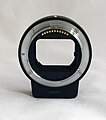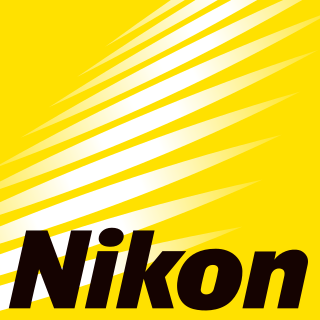
Nikon Corporation is an optics and photographic equipment manufacturer headquartered in Tokyo, Japan. The companies held by Nikon form the Nikon Group.

A digital single-lens reflex camera is a digital camera that combines the optics and mechanisms of a single-lens reflex camera with a solid-state image sensor and digitally records the images from the sensor.

The Nikon F-mount is a type of interchangeable lens mount developed by Nikon for its 35mm format single-lens reflex cameras. The F-mount was first introduced on the Nikon F camera in 1959, and features a three-lug bayonet mount with a 44 mm throat and a flange to focal plane distance of 46.5 mm. The company continues, with the 2020 D6 model, to use variations of the same lens mount specification for its film and digital SLR cameras.

The Nikon D90 is a 12.3 megapixel digital single-lens reflex camera (DSLR) model announced by Nikon on August 27, 2008. It is a prosumer model that replaces the Nikon D80, fitting between the company's entry-level and professional DSLR models. It has a Nikon DX format crop sensor.

A mirrorless camera is a digital camera which, in contrast to DSLRs, does not use a mirror in order to ensure that the image presented to the photographer through the viewfinder is identical to that taken by the camera. They have come to replace DSLRs, which have historically dominated interchangeable lens cameras. Other terms include electronic viewfinder interchangeable lens (EVIL) cameras and compact system cameras (CSCs).

The Nikon D3100 is a 14.2-megapixel DX format DSLR Nikon F-mount camera announced by Nikon on August 19, 2010. It replaced the D3000 as Nikon's entry level DSLR. It introduced Nikon's new EXPEED 2 image processor and was the first Nikon DSLR featuring full high-definition video recording with full-time autofocus and H.264 compression, instead of Motion JPEG compression. It was also the first Nikon DSLR to provide high-definition video recording at more than one frame rate.

The Pentax K-5 is a 16.3-megapixel digital single-lens reflex camera, announced on September 20, 2010. It began shipping in mid-October 2010 and it was replaced by the Pentax K-5 II in the third quarter of 2012.

The Nikon 1 series is a discontinued camera line from Nikon, originally announced on 21 September 2011. The cameras utilized Nikon 1-mount lenses, and featured 1" CX format sensors.

The Nikon 1 J1 is a Nikon 1 series high-speed mirrorless interchangeable-lens camera with 1" sensor size launched by Nikon on September 21, 2011. It is a new model that focuses on high-performance, portability and versatility. Nikon lists the estimated selling price of the Nikon 1 J1 One-Lens Kit in the United States at $649.95. Released on October 20, 2011, this kit comes with the 1 NIKKOR VR 10-30mm f/3.5-5.6 lens.

The Nikon Expeed image/video processors are media processors for Nikon's digital cameras. They perform a large number of tasks: Bayer filtering, demosaicing, image sensor corrections/dark-frame subtraction, image noise reduction, image sharpening, image scaling, gamma correction, image enhancement/Active D-Lighting, colorspace conversion, chroma subsampling, framerate conversion, lens distortion/chromatic aberration correction, image compression/JPEG encoding, video compression, display/video interface driving, digital image editing, face detection, audio processing/compression/encoding and computer data storage/data transmission.

The Nikon 1 S1 is a Nikon 1 series low-cost high-speed mirrorless interchangeable-lens camera launched by Nikon. Nikon lists the estimated selling price of the Nikon 1 S1 One-Lens Kit in the United States at $499.95. This kit comes with the 1 NIKKOR 11–27.5mm f/3.5-5.6 lens. It features many similarities with the 1 J2, like the same 10.1 megapixel CX-format CMOS sensor and autofocus, but with an upgraded EXPEED 3A processor.
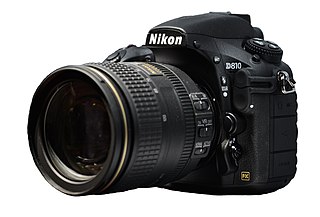
The Nikon D810 is a 36.3-megapixel professional-grade full-frame digital single-lens reflex camera produced by Nikon. The camera was officially announced in June 2014, and became available in July 2014.
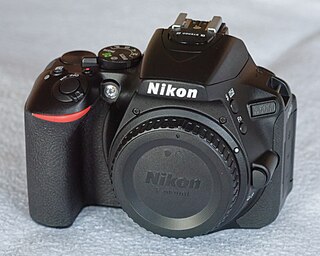
The Nikon D5600 is a 24.2 megapixel upper-entry level, APS-C sensor DSLR announced by Nikon on November 10, 2016, as the successor of the D5500. The camera has an F-mount.

The Nikon D7500 is a 20.9-megapixel digital single-lens reflex camera using an APS-C sensor. It was announced by Nikon Corporation on 12 April 2017, and started shipping on 2 June 2017. It is the successor to the Nikon D7200 as Nikon's DX format midrange DSLR.
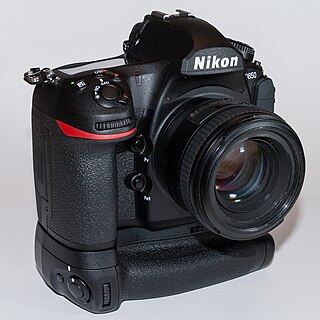
The Nikon D850 is a professional-grade full-frame digital single-lens reflex camera (DSLR) produced by Nikon. The camera was officially announced on July 25, 2017, launched on August 24, 2017, and first shipped on September 8, 2017. Nikon announced it could not fill the preorders on August 28, 2017 and filled less than 10% of preorders on the first shipping day. It is the successor to the Nikon D810.

Nikon Z-mount is an interchangeable lens mount developed by Nikon for its mirrorless digital cameras. In late 2018, Nikon released two cameras that use this mount, the full-frame Nikon Z 7 and Nikon Z 6. In late 2019 Nikon announced their first Z-mount camera with an APS-C sensor, the Nikon Z 50. In July 2020 the entry-level full-frame Z 5 was introduced. In October 2020, Nikon announced the Nikon Z 6II and Nikon Z 7II, which succeed the Z 6 and Z 7, respectively. The APS-C lineup was expanded in July 2021, with the introduction of the retro styled Nikon Z fc, and in October 2021, Nikon unveiled the Nikon Z 9, which effectively succeeds the brand's flagship D6 DSLR. The APS-C lineup was further expanded with the Nikon Z 30, announced at the end of June 2022. The Nikon Z6III was announced in June 2024.

The Nikon Z 6 is a full-frame mirrorless interchangeable-lens camera produced by Nikon. The camera was officially announced on August 23, 2018, to be released in November. Nikon began shipping the Z 6 to retailers on November 16, 2018. This was the second camera to use Nikon's new Z-mount system after the release of the 45.75 megapixel Nikon Z 7 in September 2018.

The Canon EOS R is the first full-frame mirrorless interchangeable-lens camera (MILC) produced by Canon. It was announced days after Nikon's first full-frame MILC, the Nikon Z 7, and five years after Sony's first, and was released in October 2018. The camera is the first of Canon's new EOS R system, and the first to use the RF lens mount. The "R" stands for "Reimagine optical excellence".

The Nikon Z 9 is a full-frame mirrorless camera produced by Nikon. The camera was announced on October 28, 2021.





